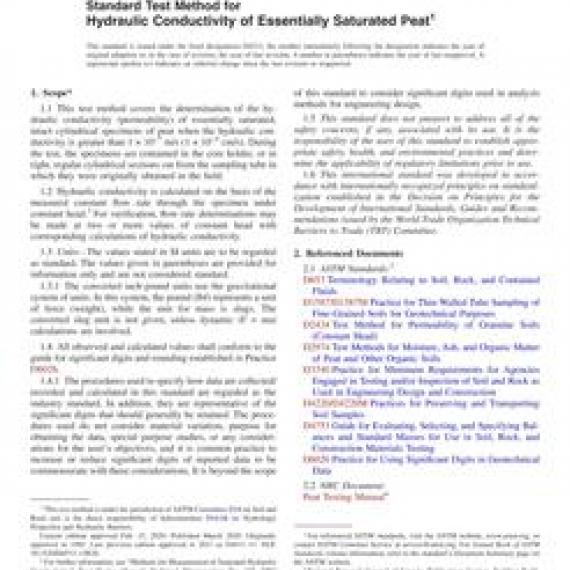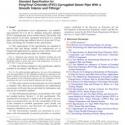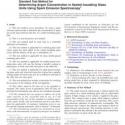No products
ASTM D4511-11(2020)
ASTM D4511-11(2020) Standard Test Method for Hydraulic Conductivity of Essentially Saturated Peat
standard by ASTM International, 02/15/2020
Full Description
1.1This test method covers the determination of the hydraulic conductivity (permeability) of essentially saturated, intact cylindrical specimens of peat when the hydraulic conductivity is greater than 1 107 m/s (1 105 cm/s). During the test, the specimens are contained in the core holder, or in right, regular cylindrical sections cut from the sampling tube in which they were originally obtained in the field.
1.2Hydraulic conductivity is calculated on the basis of the measured constant flow rate through the specimen under constant head.2 For verification, flow rate determinations may be made at two or more values of constant head with corresponding calculations of hydraulic conductivity.
1.3Units-The values stated in SI units are to be regarded as standard. The values given in parentheses are provided for information only and are not considered standard.
1.3.1The converted inch-pound units use the gravitational system of units. In this system, the pound (lbf) represents a unit of force (weight), while the unit for mass is slugs. The converted slug unit is not given, unless dynamic (F = ma) calculations are involved.
1.4All observed and calculated values shall conform to the guide for significant digits and rounding established in Practice D6026.
1.4.1The procedures used to specify how data are collected/recorded and calculated in this standard are regarded as the industry standard. In addition, they are representative of the significant digits that should generally be retained. The procedures used do not consider material variation, purpose for obtaining the data, special purpose studies, or any considerations for the user's objectives, and it is common practice to increase or reduce significant digits of reported data to be commensurate with these considerations. It is beyond the scope of this standard to consider significant digits used in analysis methods for engineering design.
1.5This standard does not purport to address all of the safety concerns, if any, associated with its use. It is the responsibility of the user of this standard to establish appropriate safety, health, and environmental practices and determine the applicability of regulatory limitations prior to use.
1.6This international standard was developed in accordance with internationally recognized principles on standardization established in the Decision on Principles for the Development of International Standards, Guides and Recommendations issued by the World Trade Organization Technical Barriers to Trade (TBT) Committee.


































